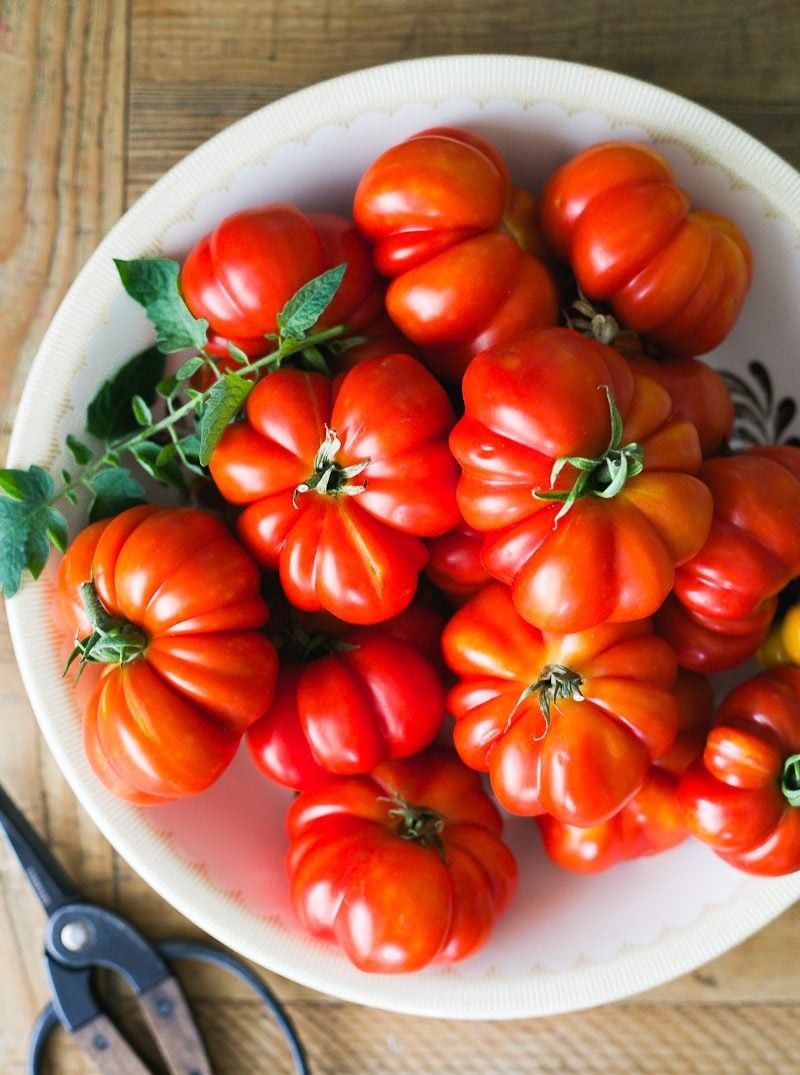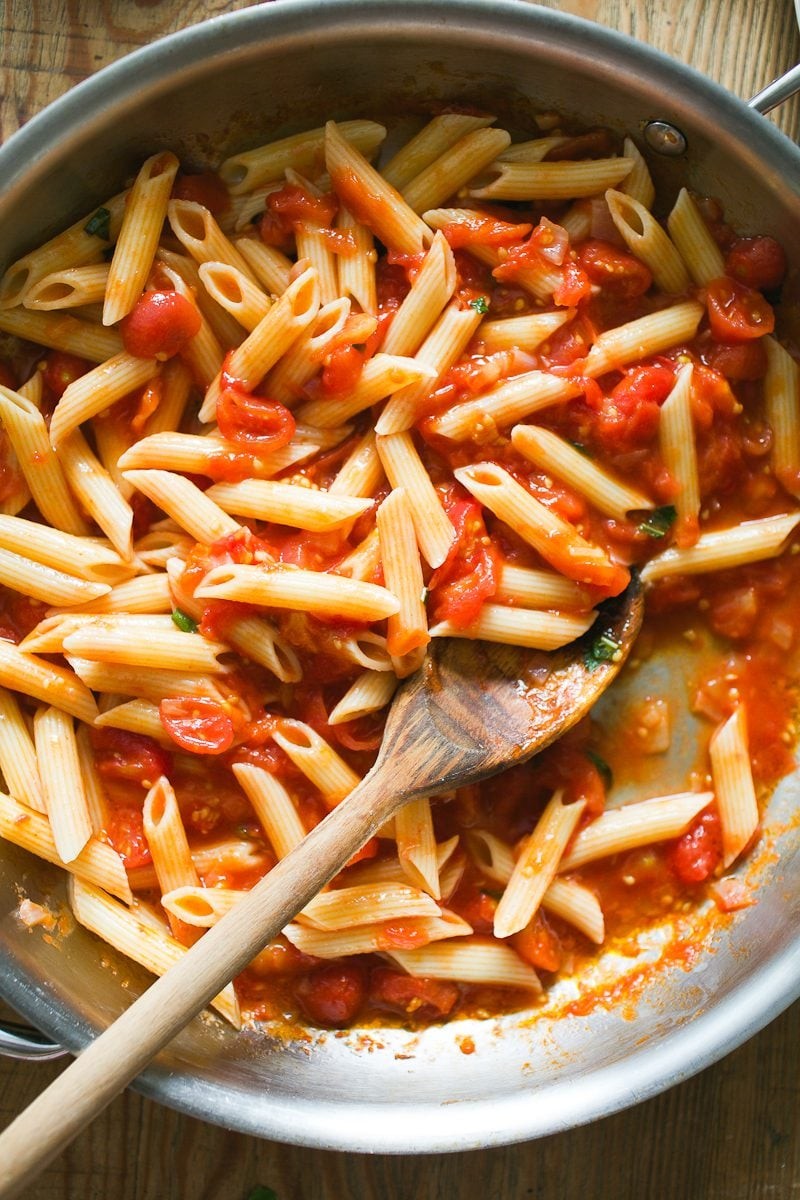Are you curious about what pomodoro sauce is and how to make it? At WHAT.EDU.VN, we offer a comprehensive guide that covers everything from the basic ingredients to advanced tips for creating the perfect pomodoro sauce. This article will explore the essence of authentic pomodoro sauce, compare it to other tomato-based sauces, and provide a detailed recipe to elevate your pasta dishes. Discover the secrets to a flavorful, homemade sauce that will impress everyone at your table.
1. What Exactly is Pomodoro Sauce?
Pomodoro sauce, at its core, is a simple yet flavorful Italian tomato sauce. The Italian word “pomodoro” translates directly to “tomato,” making it essentially “tomato sauce.” However, true authentic pomodoro sauce distinguishes itself with a focus on fresh, high-quality ingredients. The standard pomodoro sauce recipe includes fresh tomatoes, extra virgin olive oil, garlic, basil, and salt. Some variations may include onions or shallots, but traditionally, the recipe remains uncluttered, allowing the natural flavors of the tomatoes to shine.
1.1 The Essence of Authentic Pomodoro Sauce
Authenticity in pomodoro sauce hinges on the quality and freshness of its ingredients. When you prepare pomodoro sauce, using ripe, in-season tomatoes makes a significant difference in the final product. These tomatoes provide a natural sweetness and acidity that canned tomatoes often lack. The use of extra virgin olive oil not only adds richness but also contributes to the sauce’s smooth texture. Fresh basil imparts an aromatic quality, enhancing the overall sensory experience of the sauce.
1.2 Fresh vs. Canned Tomatoes
While fresh tomatoes are ideal, good-quality canned San Marzano tomatoes can serve as a convenient substitute. Fresh tomatoes, especially when in season, offer a brighter and more delicate flavor. Canned tomatoes, on the other hand, provide a deeper, richer taste due to the canning process, which concentrates the tomato flavor. The choice between fresh and canned depends largely on personal preference and the availability of fresh, ripe tomatoes.
1.3 Pomodoro Sauce vs. Other Tomato-Based Sauces
Pomodoro sauce is often compared to other tomato-based sauces, such as marinara sauce. While both share similar ingredients, there are key differences. Marinara sauce, traditionally, is associated with seafood dishes. In Italian, “marinara” means “sailor,” and alla marinara typically denotes a dish served with seafood like mussels. Marinara sauce often includes additional herbs and spices beyond basil, giving it a different flavor profile. Unlike pomodoro sauce, marinara often has a longer cooking time, allowing the flavors to meld more thoroughly.
1.4 Uses of Pomodoro Sauce
Pomodoro sauce is incredibly versatile. It’s perfect for pasta dishes, serving as a base for pizzas, or enhancing meat and vegetable dishes. Its simplicity makes it an excellent canvas for adding other ingredients, like chili flakes for arrabbiata sauce or cream for a richer, creamier sauce. Pomodoro sauce is also a great topping for gnocchi or as a dipping sauce for breadsticks. The possibilities are endless, limited only by your culinary imagination.
2. Essential Ingredients for Making Pomodoro Sauce
To make an authentic and delicious pomodoro sauce, you need a few key ingredients. Each component plays a vital role in creating the sauce’s unique flavor and texture.
2.1 Tomatoes
The cornerstone of pomodoro sauce is, of course, tomatoes. The best types of tomatoes to use are those that are sweet, juicy, and have a good balance of acidity. San Marzano, Roma, and Costoluto Fiorentino tomatoes are excellent choices. If using canned tomatoes, opt for San Marzano varieties for the best flavor. Always ensure your tomatoes are ripe and of high quality, as this significantly impacts the final taste of your sauce.
2.2 Extra Virgin Olive Oil
Extra virgin olive oil adds richness and depth to the sauce. It also helps to sauté the garlic and onions, releasing their flavors into the sauce. Choose a good-quality extra virgin olive oil with a robust flavor to enhance the overall taste of the pomodoro sauce. The olive oil should be fresh and not have any off-putting odors or flavors.
2.3 Garlic
Garlic is a fundamental aromatic in pomodoro sauce. It provides a pungent, savory note that complements the sweetness of the tomatoes. Use fresh garlic cloves and sauté them lightly in olive oil before adding the tomatoes. Be careful not to burn the garlic, as this can impart a bitter taste to the sauce.
2.4 Basil
Fresh basil is the herb of choice for pomodoro sauce. It adds a fresh, slightly sweet, and aromatic quality to the sauce. Add the basil towards the end of the cooking process to preserve its flavor and aroma. Tearing the basil leaves by hand, rather than chopping them, helps release their essential oils and enhances their flavor.
2.5 Salt
Salt is crucial for seasoning and enhancing the flavors of the other ingredients. Use sea salt or kosher salt to season the sauce to taste. Start with a small amount and add more as needed, adjusting to your preference. Salt not only brings out the natural flavors of the tomatoes but also helps to balance the acidity.
2.6 Optional Ingredients
While traditional pomodoro sauce is simple, some variations include onions or shallots for added flavor. Onions and shallots provide a subtle sweetness and depth to the sauce. Sauté them in olive oil before adding the garlic and tomatoes. Other optional ingredients include a pinch of sugar to balance acidity, red pepper flakes for a hint of spice, and a bay leaf for added complexity.
3. Step-by-Step Guide to Making Pomodoro Sauce
Making pomodoro sauce is a straightforward process that requires patience and attention to detail. Here’s a step-by-step guide to help you create the perfect sauce.
3.1 Preparing the Tomatoes
If using fresh tomatoes, the first step is to blanch them to remove the skins. Bring a large pot of water to a boil. Cut a small “X” on the bottom of each tomato. This makes it easier to peel the skin after blanching.
Blanch the tomatoes in boiling water for about 30-60 seconds, or until the skin begins to peel away from the flesh. Remove the tomatoes from the boiling water and immediately transfer them to a bowl of ice water to stop the cooking process. Once cooled, the skins should slip off easily. Peel the tomatoes, cut them in half, and remove the seeds. Chop the tomatoes into small pieces.
3.2 Sautéing Aromatics
In a large skillet or saucepan, heat the extra virgin olive oil over medium heat. Add the minced garlic and sauté for about 30 seconds, or until fragrant. Be careful not to burn the garlic. If using onions or shallots, add them to the pan along with the garlic and sauté until they are soft and translucent, about 5-7 minutes.
3.3 Cooking the Sauce
Add the chopped tomatoes to the pan with the sautéed aromatics. Season with salt to taste. Bring the sauce to a gentle simmer, then reduce the heat to low and let it cook for about 15-20 minutes, or until the sauce has thickened slightly. Stir the sauce occasionally to prevent it from sticking to the bottom of the pan.
3.4 Adding Basil and Finishing Touches
Towards the end of the cooking process, tear the fresh basil leaves into small pieces and stir them into the sauce. Remove the sauce from the heat and let it sit for a few minutes to allow the basil to infuse its flavor. Taste the sauce and adjust the seasoning as needed. If desired, use an immersion blender to puree the sauce to your desired consistency.
3.5 Serving and Storing
Pomodoro sauce can be served immediately with your favorite pasta, gnocchi, or other dishes. It can also be stored in an airtight container in the refrigerator for up to 4 days or in the freezer for up to 3 months. When ready to use, simply reheat the sauce on the stovetop or in the microwave.
4. Tips and Tricks for the Perfect Pomodoro Sauce
To ensure your pomodoro sauce is a culinary success, here are some valuable tips and tricks to keep in mind.
4.1 Choosing the Right Tomatoes
Selecting the right tomatoes is crucial for achieving the best flavor. Look for tomatoes that are ripe, firm, and have a deep red color. San Marzano tomatoes are often considered the gold standard for sauce-making due to their sweetness and low acidity. Roma tomatoes are another excellent option, as they are meaty and have fewer seeds. If using canned tomatoes, choose whole peeled tomatoes packed in juice, rather than diced or crushed tomatoes, as they tend to have a better flavor.
4.2 Balancing Flavors
Balancing the flavors in pomodoro sauce is essential for creating a harmonious taste. If the sauce is too acidic, add a pinch of sugar to help neutralize the acidity. If it lacks depth, consider adding a small amount of tomato paste or a bay leaf during cooking. Taste the sauce frequently and adjust the seasoning as needed to achieve the perfect balance.
4.3 Achieving the Right Consistency
The consistency of pomodoro sauce is a matter of personal preference. Some people prefer a chunky sauce, while others prefer a smooth sauce. To achieve a smooth consistency, use an immersion blender to puree the sauce to your desired texture. For a chunkier sauce, simply skip the blending step and leave the tomatoes in their natural state.
4.4 Cooking Time
The cooking time for pomodoro sauce can vary depending on the type of tomatoes used and the desired consistency. Generally, the sauce should simmer for at least 15-20 minutes to allow the flavors to meld and the sauce to thicken. However, if using particularly juicy tomatoes, it may be necessary to cook the sauce for a longer period of time to reduce the liquid.
4.5 Storage Tips
Proper storage is essential for maintaining the quality and flavor of pomodoro sauce. Allow the sauce to cool completely before transferring it to an airtight container. Store the sauce in the refrigerator for up to 4 days or in the freezer for up to 3 months. When freezing, consider portioning the sauce into smaller containers for easy thawing and use.
5. Recipe Variations and Adaptations
While traditional pomodoro sauce is delicious on its own, there are many ways to customize the recipe to suit your taste preferences.
5.1 Spicy Pomodoro Sauce (Arrabbiata)
To make a spicy pomodoro sauce, simply add a pinch of red pepper flakes to the pan along with the garlic. The amount of red pepper flakes can be adjusted to control the level of spiciness. Arrabbiata sauce is particularly delicious with penne pasta or as a dipping sauce for fried calamari.
5.2 Creamy Pomodoro Sauce
For a richer and more indulgent sauce, stir in a dollop of heavy cream or crème fraîche towards the end of the cooking process. The cream adds a luxurious texture and enhances the flavors of the tomatoes and basil. Creamy pomodoro sauce is excellent with gnocchi or as a topping for baked ziti.
5.3 Pomodoro Sauce with Roasted Vegetables
To add more depth and complexity to the sauce, roast some vegetables, such as bell peppers, zucchini, and eggplant, before adding them to the sauce. Roasting the vegetables brings out their natural sweetness and adds a smoky flavor to the sauce. This variation is particularly delicious with grilled chicken or as a filling for stuffed bell peppers.
5.4 Pomodoro Sauce with Meat
To make a heartier sauce, add some browned ground beef, Italian sausage, or pancetta to the pan along with the garlic and onions. The meat adds richness and protein to the sauce, making it a complete meal. This variation is perfect for serving over pasta or as a base for lasagna.
6. Serving Suggestions and Pairings
Pomodoro sauce is a versatile sauce that pairs well with a variety of dishes. Here are some serving suggestions and pairings to inspire your culinary creations.
6.1 Pasta Dishes
Pomodoro sauce is a classic pairing for pasta dishes. It is particularly delicious with spaghetti, penne, rigatoni, and fusilli. Toss the pasta with the sauce and top with grated Parmesan cheese and fresh basil leaves for a simple yet satisfying meal.
6.2 Pizza Topping
Use pomodoro sauce as a base for homemade pizzas. Spread a thin layer of sauce over the pizza dough and top with your favorite toppings, such as mozzarella cheese, pepperoni, and vegetables. Bake the pizza in a preheated oven until the crust is golden brown and the cheese is melted and bubbly.
6.3 Gnocchi
Serve pomodoro sauce with homemade or store-bought gnocchi. Toss the gnocchi with the sauce and top with grated Parmesan cheese and fresh basil leaves. For a richer dish, bake the gnocchi in a casserole dish with mozzarella cheese and pomodoro sauce until the cheese is melted and bubbly.
6.4 Meat and Vegetable Dishes
Use pomodoro sauce to enhance meat and vegetable dishes. It is delicious with grilled chicken, baked eggplant, and stuffed bell peppers. Simmer the meat or vegetables in the sauce until they are tender and flavorful. Serve with a side of pasta or rice for a complete meal.
6.5 Dips and Appetizers
Serve pomodoro sauce as a dipping sauce for breadsticks, garlic bread, or fried calamari. Heat the sauce in a saucepan and serve warm with your favorite appetizers. It is also delicious as a topping for bruschetta or crostini.
7. Health Benefits of Pomodoro Sauce
Pomodoro sauce is not only delicious but also offers several health benefits.
7.1 Rich in Antioxidants
Tomatoes are rich in antioxidants, such as lycopene, which have been linked to a reduced risk of heart disease, cancer, and other chronic diseases. Cooking tomatoes actually increases the bioavailability of lycopene, making pomodoro sauce an excellent source of this beneficial compound.
7.2 Good Source of Vitamins and Minerals
Pomodoro sauce is a good source of vitamins and minerals, including vitamin C, vitamin A, and potassium. These nutrients are essential for maintaining overall health and supporting various bodily functions.
7.3 Low in Calories
Pomodoro sauce is relatively low in calories, making it a healthy choice for those watching their weight. It is also low in fat and cholesterol, making it a heart-healthy option.
7.4 Digestive Health
The fiber in tomatoes can help promote digestive health by preventing constipation and supporting regular bowel movements. Fiber also helps to keep you feeling full and satisfied, which can aid in weight management.
7.5 Anti-Inflammatory Properties
Some studies have suggested that the compounds in tomatoes may have anti-inflammatory properties, which could help reduce the risk of chronic diseases associated with inflammation.
8. Common Mistakes to Avoid When Making Pomodoro Sauce
To ensure your pomodoro sauce turns out perfectly, it’s essential to avoid some common mistakes.
8.1 Using Underripe or Overripe Tomatoes
Using tomatoes that are either underripe or overripe can significantly impact the flavor and texture of the sauce. Underripe tomatoes lack sweetness and have a tart taste, while overripe tomatoes can be mushy and have a fermented flavor. Always choose tomatoes that are ripe, firm, and have a deep red color.
8.2 Burning the Garlic
Burning the garlic can impart a bitter taste to the sauce. Sauté the garlic over low heat and watch it carefully to prevent it from browning too quickly. If the garlic starts to brown, remove the pan from the heat and let it cool slightly before continuing.
8.3 Overcooking the Sauce
Overcooking the sauce can result in a thick, pasty texture and a loss of flavor. Simmer the sauce over low heat and stir it occasionally to prevent it from sticking to the bottom of the pan. Cook the sauce until it has thickened slightly but is still moist and flavorful.
8.4 Not Seasoning Properly
Not seasoning the sauce properly can result in a bland and unappetizing dish. Season the sauce with salt to taste and add other seasonings as needed to balance the flavors. Taste the sauce frequently and adjust the seasoning as you go.
8.5 Using Low-Quality Olive Oil
Using low-quality olive oil can impart a greasy or bitter taste to the sauce. Choose a good-quality extra virgin olive oil with a robust flavor to enhance the overall taste of the pomodoro sauce. The olive oil should be fresh and not have any off-putting odors or flavors.
9. Frequently Asked Questions (FAQs) About Pomodoro Sauce
Here are some frequently asked questions about pomodoro sauce to help you further understand this classic Italian sauce.
| Question | Answer |
|---|---|
| What is the origin of pomodoro sauce? | Pomodoro sauce originated in Italy. The word “pomodoro” means “tomato” in Italian, and the sauce is a staple in Italian cuisine. |
| Can I use dried basil instead of fresh? | While fresh basil is preferred for its flavor, you can use dried basil as a substitute. Use about 1 teaspoon of dried basil for every tablespoon of fresh basil. |
| How do I make pomodoro sauce less acidic? | To reduce the acidity of pomodoro sauce, add a pinch of sugar or a small amount of baking soda to the sauce while it is simmering. |
| Can I add vegetables to pomodoro sauce? | Yes, you can add vegetables such as onions, carrots, and celery to pomodoro sauce for added flavor and nutrients. Sauté the vegetables before adding the tomatoes. |
| How long does pomodoro sauce last in the fridge? | Pomodoro sauce can last in the fridge for up to 3-4 days. Ensure that it is stored in an airtight container to maintain its freshness. |
| Can I freeze pomodoro sauce? | Yes, pomodoro sauce can be frozen for up to 2-3 months. Allow it to cool completely before transferring it to a freezer-safe container or bag. |
| Is pomodoro sauce vegan? | Yes, traditional pomodoro sauce is vegan as it is made from tomatoes, olive oil, garlic, basil, and salt, which are all plant-based ingredients. |
| What is the difference between pomodoro and marinara sauce? | Pomodoro sauce typically has fewer ingredients and a shorter cooking time compared to marinara sauce. Marinara often includes additional herbs and a longer simmer. |
| Can I use different types of tomatoes? | Yes, you can use different types of tomatoes such as San Marzano, Roma, or cherry tomatoes. The type of tomato will affect the flavor and texture of the sauce. |
| How do I thicken pomodoro sauce? | To thicken pomodoro sauce, simmer it uncovered over low heat to allow excess moisture to evaporate. You can also add a small amount of tomato paste to help thicken it. |


10. Why You Should Ask Your Questions on WHAT.EDU.VN
Finding reliable answers to your questions can be challenging. At WHAT.EDU.VN, we strive to provide accurate, comprehensive, and user-friendly information on a wide range of topics. If you have more questions about pomodoro sauce or any other subject, we encourage you to visit our website and ask us anything. Our team of experts is dedicated to providing you with the answers you need, quickly and for free.
Do you have more questions and need answers? Don’t hesitate! Visit WHAT.EDU.VN now to ask your questions and receive free, expert advice. Our platform is designed to help you find the information you need quickly and easily. Connect with a community of knowledgeable individuals ready to assist you. Your journey to discovery starts here!
Contact Us:
- Address: 888 Question City Plaza, Seattle, WA 98101, United States
- WhatsApp: +1 (206) 555-7890
- Website: what.edu.vn

